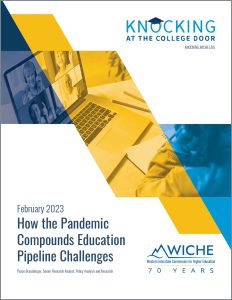The Western Interstate Commission for Higher Education (WICHE) has released new analysis that suggests COVID-19’s impacts in the K-12 pipeline may present additional long-term enrollment challenges to those which postsecondary leaders and institutions are already grappling with.
According to WICHE’s comparison of public school enrollment and high school graduate levels through 2021 to the pre-pandemic projections published in 2020, 2% fewer students enrolled in public schools, nationwide, in fall 2021, than could have been expected, approximately 833,000 students.
After strong unexpected declines in fall 2020, the rate of decline at the elementary school level was more in line with declines that had previously been predicted by demographic contraction.
Other key takeaways can be found in the PDF of the report and browsed below. The additional state-level public school enrollment and high school graduate data that WICHE has obtained since publishing the 2020 edition of projections are also available as a downloadable dataset.
Available data suggest relative stability of high school graduation for the 11th or 12th graders in the first two graduating classes impacted by the pandemic. But data about the third impacted graduating class is only beginning to emerge.
Fewer school middle school students in fall 2021 than predicted by pre-pandemic trends, and notable impacts on learning proficiency, could suggest even fewer public high school graduates after 2025 than were already predicted.
A bulge in the number of ninth graders and reports of high school students struggling could indicate a reduction in high school graduates over the next four years, which would dampen the already modest graduate increase forecast around 2025.
Enrollment variations indicate greater pandemic impacts for student populations historically underserved in education, which could further exacerbate the projected contraction in high school graduate numbers.
It remains unclear the extent to which the students expected in public schools are homeschooling or in private schools. While there appears to be no single explanation for why fewer students were enrolled in the public schools in 2020-21 and 2021-22 than were previously projected, the accumulating data and research suggest there are students who may be falling off course or could disengage from schooling altogether, and this may forebode future impacts on high school graduate numbers.

